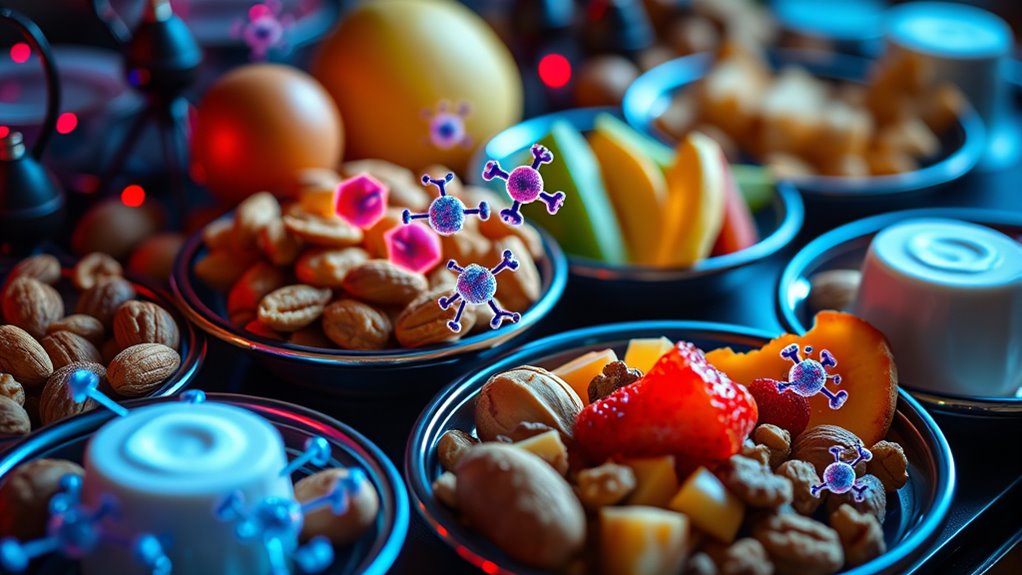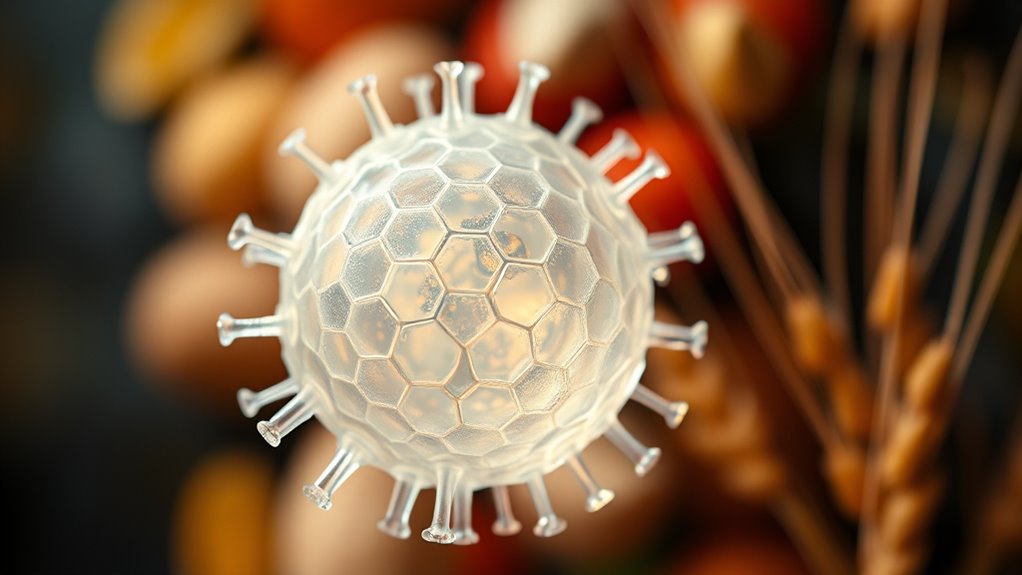Food allergies and sensitivities involve different immune responses. Allergies trigger a rapid, potentially severe reaction through IgE antibodies, causing symptoms like hives, swelling, and breathing issues. Sensitivities involve a milder, delayed response mainly from IgG antibodies, leading to digestive problems and systemic discomfort. Recognizing these immunological differences helps you manage your symptoms more effectively and avoid unnecessary restrictions. If you want to understand how these responses differ and their implications, keep exploring this topic further.
Key Takeaways
- Food allergies involve IgE antibodies triggering rapid immune responses, while sensitivities involve IgG antibodies causing delayed, milder symptoms.
- Allergic reactions activate mast cells, releasing histamine, leading to symptoms like hives and breathing issues; sensitivities do not involve mast cells.
- Allergies often cause immediate, severe reactions; sensitivities typically result in milder, delayed digestive or systemic discomfort.
- Diagnosis of allergies includes skin tests and oral challenges; sensitivities are identified through elimination diets and IgG testing.
- Management of allergies requires strict avoidance and emergency plans; sensitivities are managed via lifestyle and dietary modifications.
Understanding Food Allergies and Sensitivities

Understanding the difference between food allergies and sensitivities can help you manage your health more effectively. Food labeling plays a crucial role, as clear labels can alert you to potential allergens, preventing reactions. When you’re unsure about ingredients, allergen testing can provide clarity by identifying specific triggers. Allergies involve an immune response, often causing severe symptoms, while sensitivities are typically milder and don’t involve the immune system directly. Recognizing these distinctions helps you decide whether to avoid certain foods or seek medical advice. Always read food labels carefully, and consider allergen testing if you suspect a problem. Food sensitivities are often more difficult to diagnose than allergies, requiring careful monitoring of reactions to different foods. This proactive approach empowers you to make safer choices, reducing health risks and improving your overall well-being.
The Immune System’s Role in Allergic Reactions

When your body encounters a food allergen, your immune system springs into action, treating the substance as a threat. It triggers immune responses through sensitization processes, where your immune cells recognize and remember the allergen. During sensitization, specialized cells called B cells produce IgE antibodies specific to that allergen, which attach to mast cells. Upon subsequent exposure, these mast cells rapidly release chemicals like histamine, causing allergy symptoms. This immune memory is what makes allergic reactions quick and sometimes severe. Your immune system’s ability to remember and respond to allergens is central to allergies. It differentiates allergic responses from other food reactions, like sensitivities, which involve different immune mechanisms. Understanding this process highlights how your immune system plays a vital role in allergic reactions. Additionally, the immune system’s response can be influenced by diverse designs and materials in products like planters that interact with the environment, although in a different context.
How Food Sensitivities Affect the Body

When you have a food sensitivity, you might notice digestive issues like bloating, gas, or stomach pain. Your immune system responds differently than with allergies, often causing subtle symptoms. Understanding these effects can help you identify triggers and improve your overall health. Advances in natural language processing are also making it easier to develop tools that assist in tracking and managing food sensitivities. Additionally, home heating solutions such as improved insulation and ventilation can contribute to healthier indoor environments, indirectly supporting individuals with sensitivities by reducing indoor pollutants. Emerging automation technologies are also being utilized to personalize dietary recommendations for those with food sensitivities.
Digestive Discomforts Emerge
Food sensitivities can quietly disrupt your digestive system, leading to discomfort that often goes unnoticed or is mistaken for other issues. You might experience gastrointestinal symptoms like bloating, gas, or stomach cramps, which are common signs of food intolerance. These symptoms can develop hours after eating and vary in intensity. Recognizing these signs is key to managing your health. Here’s a quick overview: My dog’s names can also be a helpful tool in identifying sensitivities if they react differently to certain foods. Understanding immune response mechanisms can further aid in differentiating sensitivities from allergies. Additionally, tuning methods used in automotive modifications highlight how precise adjustments can optimize performance, much like identifying specific food sensitivities requires targeted attention.
Immune System Response
While digestive discomforts from food sensitivities often seem isolated to your stomach, they can also trigger a broader immune response. Your immune system may recognize certain foods as harmful, leading to immune memory formation. This process involves the production of specific antibodies, such as IgG, which can persist and cause ongoing symptoms. Unlike allergies, where immune responses are rapid and intense, food sensitivities typically provoke delayed reactions through subtle immune mechanisms. When you consume a trigger food, your immune system may produce antibodies that recognize it in future exposures, amplifying symptoms over time. This immune response can contribute to inflammation and systemic discomfort, affecting more than just your digestive tract. Recognizing this immune activity helps explain why sensitivities can cause persistent, widespread symptoms. Additionally, the presence of antioxidant-rich foods can help modulate immune responses and reduce inflammation associated with sensitivities. Incorporating immune-supportive nutrients may further assist in managing these reactions and promoting overall health. Understanding the underlying immune mechanisms involved in sensitivities can improve approaches to treatment and symptom management.
The Mechanisms Behind Food Allergies

Have you ever wondered what happens inside your body during a food allergy? When you encounter an allergen, your immune system triggers an IgE immune response. This response causes your immune cells to produce specific IgE antibodies that recognize the allergen. These antibodies attach to mast cells, which are found throughout your body, especially in your skin and mucous membranes. Upon subsequent exposure to the same allergen, it binds to the IgE on mast cells, leading to their activation. This activation releases chemicals like histamine, causing allergy symptoms. Mast cell activation plays a vital role in the allergic reaction, rapidly releasing these substances to defend against what your immune system mistakenly sees as a threat. This process explains the quick onset of allergic symptoms after allergen exposure. Additionally, high-quality projectors can be used to display educational content about immune responses, enhancing understanding through visual aids. Understanding the immune response mechanisms can help in developing better allergy treatments and management strategies. Recognizing the importance of immune regulation can further improve approaches to treating allergies and preventing overreactions.
Common Symptoms of Allergies and Sensitivities

Symptoms of allergies and sensitivities can vary widely, but they often develop quickly after exposure to an allergen or trigger. You might notice skin reactions like hives, redness, or swelling, which are common signs of an allergic response. Respiratory symptoms are also typical, including sneezing, nasal congestion, coughing, or wheezing. These symptoms can appear suddenly and may be severe, especially in allergies. Sensitivities can cause milder or more delayed reactions, such as stomach discomfort or fatigue, but skin and respiratory issues are among the most noticeable. Recognizing these symptoms early helps you identify potential food reactions and seek appropriate care. Understanding these symptoms can facilitate early intervention and better management strategies. Whether immediate or delayed, understanding these common signs is key to managing allergies and sensitivities effectively. Additionally, immune response principles can be applied to optimize your body’s responses and overall resilience.
Diagnostic Approaches for Food Reactions

Diagnosing food reactions involves a combination of detailed medical history, elimination diets, and specific testing methods. First, you’ll review your history to identify potential triggers. Second, elimination diets help pinpoint problematic foods by removing and reintroducing items systematically. Third, tests like genetic testing can reveal predispositions to sensitivities or allergies. These approaches work together to clarify whether your symptoms stem from sensitivities or allergies. Genetic testing can identify genetic markers associated with immune responses, aiding diagnosis. Elimination diets, carefully monitored, help confirm food-related reactions without relying solely on lab results. Incorporating accurate testing methods ensures a more reliable diagnosis, reducing the risk of misinterpretation. Combining these methods provides a thorough picture, helping you and your healthcare provider determine the best next steps for managing your food reactions effectively. Additionally, understanding the immunological differences between sensitivities and allergies is crucial for appropriate treatment and management. Recognizing the diverse immune responses involved can guide personalized interventions and improve outcomes.
Differences in Treatment and Management

Understanding how to manage food sensitivities and allergies is essential because their treatments differ considerably. For food allergies, strict avoidance and emergency plans are crucial, often involving carrying epinephrine. Food sensitivities may require nutritional adjustments and lifestyle modifications to reduce symptoms without complete elimination. Your goal is to balance your diet while avoiding triggers. The table below highlights emotional differences in managing these conditions:
| Food Allergies | Food Sensitivities |
|---|---|
| Immediate, severe reactions | Gradual, less intense discomfort |
| Emergency preparedness essential | Focus on lifestyle adjustments |
| Strict avoidance needed | Moderate dietary changes |
| Risk of life-threatening reactions | Manageable symptoms |
| Requires medical intervention | Often manageable through diet |
Additionally, understanding the immunological differences between allergies and sensitivities helps tailor appropriate management strategies.
The Importance of Accurate Identification

Getting an accurate diagnosis is key to managing your food reactions effectively. If misidentification occurs, you might follow treatments that don’t address your actual condition, risking ongoing symptoms or health issues. Knowing how to properly identify your sensitivities or allergies allows you to create a personalized plan that keeps you safe and comfortable.
Correct Diagnosis Methods
Accurate identification of food sensitivities and allergies is essential because misdiagnosis can lead to unnecessary dietary restrictions or overlooked health risks. To get it right, healthcare providers often use specific methods such as:
- Blood tests: These can detect immune responses by measuring antibodies like IgE or IgG, helping distinguish allergies from sensitivities.
- Elimination diets: You remove suspected foods for a period, then reintroduce them to observe reactions, pinpointing problematic foods.
- Oral food challenges: Under medical supervision, you consume small amounts of the suspected food to confirm or rule out allergies or sensitivities.
Using these methods ensures you avoid unnecessary restrictions and properly address your symptoms. Accurate diagnosis is the foundation for effective management and better health outcomes.
Impact of Misidentification
Misidentifying food sensitivities and allergies can lead to serious health and lifestyle consequences. Labeling issues often cause confusion, making it difficult to determine which foods are truly problematic. Incorrect labels or misunderstood ingredients can result in unnecessary dietary restrictions or exposure to allergens, risking severe reactions. Nutritional misunderstandings also arise when sensitivities are mistaken for allergies or vice versa, leading you to avoid essential nutrients or over-restrict your diet. This misidentification can cause weight loss, deficiencies, or poor overall health. Additionally, it hampers your ability to make informed choices, increasing frustration and anxiety around eating. Accurate identification is essential to prevent these issues, ensuring you follow a safe, balanced diet tailored to your specific needs.
Tailored Treatment Plans
When your food sensitivities or allergies are correctly identified, healthcare providers can develop treatment plans that are specifically tailored to your needs. This personalized nutrition approach considers your unique responses and helps manage symptoms effectively. To create an effective plan, they’ll typically:
- Pinpoint your specific food triggers through testing and history.
- Design a diet that respects your dietary restrictions without sacrificing essential nutrients.
- Educate you on reading labels and avoiding cross-contact to prevent reactions.
A tailored treatment plan ensures you avoid unnecessary eliminations, improves your quality of life, and reduces the risk of nutritional deficiencies. Accurate identification empowers you to make informed choices, helping you stick to your dietary restrictions with confidence and ease.
Frequently Asked Questions
Can Food Sensitivities Develop Suddenly Without Prior Symptoms?
Yes, food sensitivities can develop suddenly without prior symptoms. Your immune response might change over time, leading to delayed symptom onset even if you previously tolerated certain foods. Factors like stress, illness, or changes in your gut health can trigger these new sensitivities. You might not notice symptoms immediately, but your immune system can start reacting to foods unexpectedly, making it seem like the sensitivity appeared out of nowhere.
Are Food Allergies More Common Than Food Sensitivities Worldwide?
You might wonder if food allergies are more common than sensitivities worldwide. The prevalence disparity shows allergies tend to be more frequent, with global statistics indicating higher rates. Food allergies often cause immediate, severe reactions, making them more noticeable. Sensitivities are subtler and less documented, so they might appear less common. Overall, allergies generally have a higher prevalence globally, but sensitivities are still significant and sometimes underreported.
How Do Cross-Reactivities Influence Food Allergy Symptoms?
Cross-reactivities substantially influence food allergy symptoms through mechanisms involving immune response interactions. When your immune system confuses proteins in different foods due to similar structures, it triggers cross reactivity mechanisms. This means you might react to multiple foods with one allergy, intensifying symptoms. Recognizing these interactions helps you understand why certain foods cause reactions and guides you in avoiding triggers, ultimately managing your allergy more effectively.
Can Food Sensitivities Cause Long-Term Health Issues?
While food sensitivities might seem minor, they can quietly contribute to chronic inflammation, which impacts your digestive health over time. You may not notice immediate issues, but persistent sensitivities can lead to long-term problems like bloating, discomfort, or nutrient absorption concerns. Addressing these sensitivities early can help maintain your overall health, prevent ongoing digestive distress, and support a balanced, resilient immune system.
What Are Emerging Treatments for Food Sensitivities and Allergies?
Emerging treatments for food sensitivities and allergies focus on immune modulation and microbiome therapy. You might explore approaches like targeted probiotics to restore gut balance, which can reduce sensitivity symptoms. Additionally, immune modulation therapies aim to retrain your immune system, decreasing allergic responses. These innovative treatments are promising, offering potential long-term relief and improved quality of life by addressing the root causes of food-related immune reactions.
Conclusion
Understanding the differences between food sensitivities and allergies helps you take control of your health, much like a seasoned alchemist mastering a potion. By accurately identifying your reactions, you can avoid unnecessary suffering and find effective management strategies. Remember, whether it’s a pesky sensitivity or a true allergy, knowing the signs and seeking proper diagnosis guarantees you can enjoy your meals without fear. Stay vigilant, and don’t let hidden food reactions cast a shadow over your wellbeing.









